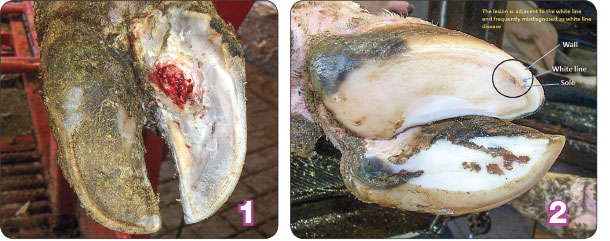When talking about hoof lesions, stop using the “a” word. On many hoof trimming records, the term “abscess” is a catchall for just about any insult to a dairy cow’s foot, but according to University of Minnesota’s Dr. Gerard Cramer, “That doesn’t tell us anything.”
Cramer teamed up with Dr. Nigel Cook from the Dairyland Initiative for the Professional Dairy Producers’ hoof care workshop series held in April in Wisconsin. The two experts challenged dairymen and hoof trimmers to expand their vocabulary to accurately identify the lesions that lead to lameness and enter them onto hoof health records.
Armed with this data, they explained how dairies can adjust management practices to improve lameness and hoof health.

Most often, that pus-filled “abscess” on the bottom of a cow’s foot is really a sole ulcer or white-line disease. These two types of lesions have different causes, which is why knowing their true identity is critical in mitigating the risk factors associated with them.
Cramer and Cook discussed the circumstances that commonly cause sole ulcers and white-line disease and what to do about them.
Sole ulcers
What are the risk factors?
Sole ulcers occur from the inside out. Nutrition and hormonal changes are often the factors leading up to these lesions, particularly around the time of calving.
Ligaments within the hoof loosen, allowing the pedal bone inside of the claw capsule to sink lower as the cow walks. At the same time, the fat pad underneath this bone wears thin. With little or no cushion left to absorb weight, the pedal bone causes direct damage to the corium, the layer from which horn growth occurs. This is why sole ulcers tend to show up in early lactation.
How to reduce the risk
While the hormonal changes the cow undergoes cannot be avoided, there are a few things dairymen can do to relieve pain and promote recovery.
From a cow comfort standpoint, encourage cows to lie down at least 12 hours per day, thus taking pressure off of their feet, by providing comfortable stalls/stall surfaces and adequate heat abatement. Strive for stocking density at less than 1.2 cows per stall, and limit total time out of the pen for milking to less than three hours per day.
A ration that maximizes dry matter intake in early lactation to obtain sufficient body condition can also be helpful, as well as routine hoof trimming.
White-line disease
What are the risk factors?
White-line disease occurs where the sole of the foot meets the wall of the claw. This is an exceptionally weak point of anatomy, yet it is also the place where maximum force occurs as the cow walks.
Unlike sole ulcers that start inside of the hoof, white-line disease is the result of outside forces. Particularly, poor flooring and poor animal handling create this problem. A floor surface that is excessively rough or has rough edges may cause trauma to the foot; on the other hand, a floor that is too smooth can lead to slipping.
Even a floor with grooving can be slippery if the grooves are too shallow or spaced too far apart. The injury risks of a faulty floor rise when cows are pressured by people to move more quickly than their natural pace.
Mechanical equipment can make matters worse. For example, a crowd gate in a holding area with a poor floor surface may cause cows to slip or hurt their feet, putting additional pressure on the white line.
Excessive wear, noted in facilities where cows must walk more than one building distance from the milking parlor, is a risk factor too.
How to reduce the risk
Troubleshoot the environment, noting areas where cows must make a turn, such as the exit or entrance to the holding area. Ensure there is good footing here. Lining the holding area and parlor with rubber is also a strategic way to improve surfaces where cows spend a period of time standing.
Further, properly train employees to practice low-stress cattle handling techniques that allow cows to move at their own pace.
How to treat hoof lesions
Sole ulcers and white-line lesions can often be successfully treated with proper trimming. This means a functional trim that balances weight-bearing and relieves pressure that causes pain. Dead (necrotic) tissue should be removed but done so carefully as to minimize damage to the corium.
Blocking the healthy claw is an effective way to relieve pressure from the infected claw. A block should be placed at a 90-degree angle to the leg, and it should be large enough to cover the entire heel, where the most weight-bearing occurs.
Re-check blocks at four to six weeks to monitor healing. At this time, decide if the block should be removed, adjusted or re-applied.
Moving cows to an area with deep, loose bedding is also key to recovering from hoof lesions.
In most cases, antibiotics and wraps are not necessary for treating sole ulcers and white lines because these lesions are not caused by an infectious organism. The infection can often be controlled by opening up the lesion and exposing it to oxygen, therefore creating a hostile environment for anaerobic bacteria. PD
PHOTO: 1. Metabolic and mechanical factors contribute to the formation of sole ulcers, which are the most common claw lesion seen in confinement facilities. 2. A thin sole toe ulcer has a similar appearance to white line disease, but it is caused by abrasive flooring, excessive wear or overtrimming. Photos provided by Dr. Jan Shearer.

-
Peggy Coffeen
- Editor
- Progressive Dairyman
- Email Peggy Coffeen







